VIDEO: 8 of the Worst Lawn Weeds in Southern Maryland (and What to Do About Them)
When it comes to your image of the perfect lawn, there is probably one thing that will spoil your vision more than anything else: weeds.
They’re tall and prickly and spiky and look completely out of place in your well-manicured front yard. What’s more, is they make your lawn look neglected and take away from the overall beauty and enjoyment of your yard!
Lawn weeds are the worst because they sneak in before your lawn has a chance to get nice and thick during the growing season. And just when you’re getting ready to get out there and enjoy your lawn via a nice game of fetch with the dog or to just unwind after a hard day, those weeds come along and ruin it.
Weeds are advantageous. They like to pop in whenever they get the chance. You don’t want those weeds popping up throughout the growing season, taking away from the overall beauty and enjoyment of your lawn.
Here are 8 of the most common lawn weeds in Maryland and how you can keep them out of your lawn.
Common Lawn Weeds in Maryland: Spring Weeds
Let’s start with the early spring invaders. These are winter weeds that actually germinate in the late fall and then grow very slowly winter long, making their appearance most known in spring.
Use This Lawn Weed ID Tool to Spot Weeds in Your Lawn
These are the first lawn weeds that show up right when you’re eager to get outside and enjoy the warmer weather. They are your first unwelcome visitors that stand out very clearly when you’re paying so much attention to the sunshine and the fresh air.
1. Chickweed
Chickweed is common and one of the easiest to spot lawn weeds, growing low with white flowers. There are five petals on each of the flowers, resembling little stars.
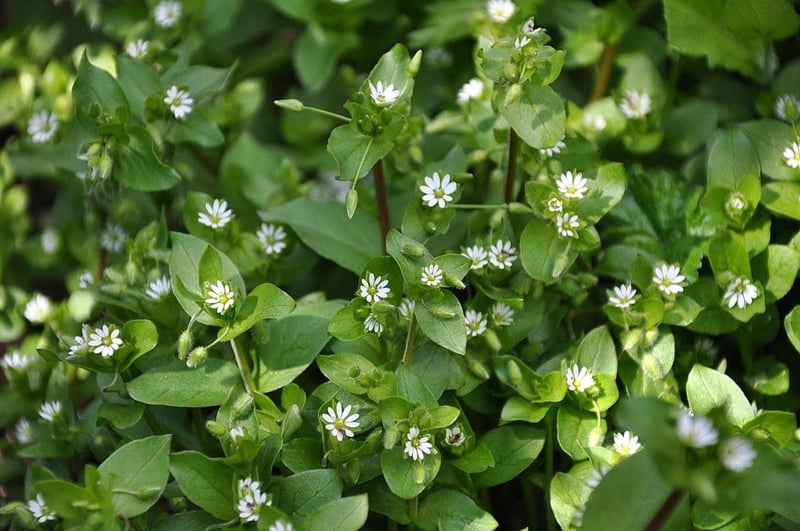 And a wet, early spring powers chickweed even more. Follow that up with early summer rains and chickweed will linger.
And a wet, early spring powers chickweed even more. Follow that up with early summer rains and chickweed will linger.
2. Henbit
Henbit is a winter annual weed as well.
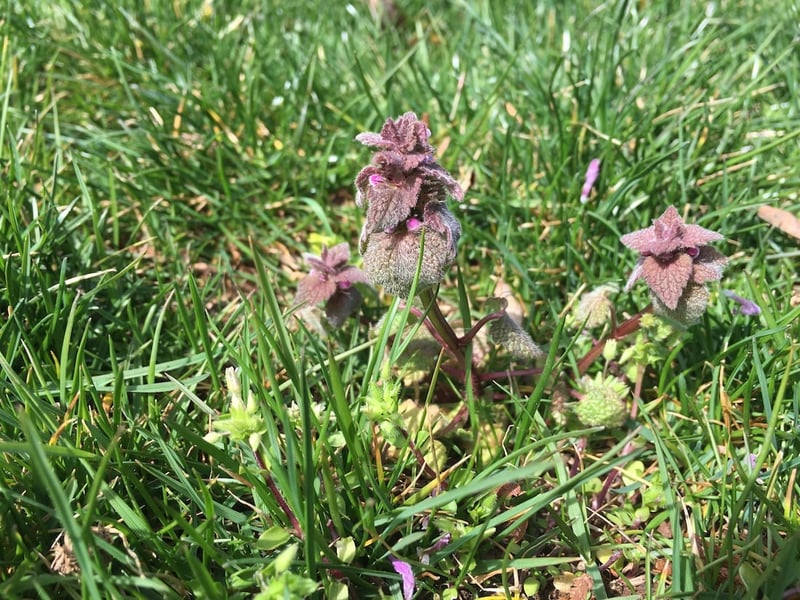 This is one of the lawn weeds that stands out in the spring with deep purple flowers. After this lawn weed flowers, it’s more difficult to control. But then they usually die back when warmer weather arrives in late spring. However, that could be months later.
This is one of the lawn weeds that stands out in the spring with deep purple flowers. After this lawn weed flowers, it’s more difficult to control. But then they usually die back when warmer weather arrives in late spring. However, that could be months later.
3. Bittercress
Bittercress is the worst because it can grow into a tall eyesore if left to its own demise. And when bittercress reaches its full height, the seed pods actually explode and you’ll have more of this weed next year.
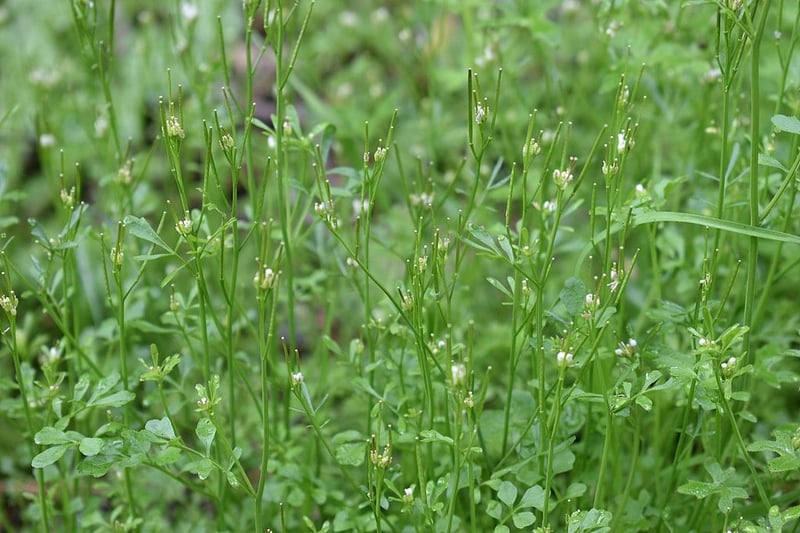 Excess water and rain, as well as poor drainage, can make these lawn weeds worse.
Excess water and rain, as well as poor drainage, can make these lawn weeds worse.
For these early spring lawn invaders, a thick, healthy lawn is your best defense. If you know you have a spring weed problem, we can treat them as part of a comprehensive lawn care program to keep them at bay.
Common Lawn Weeds in Maryland: Early Summer Weeds
Once the weather warms up even more and spring rains subside, that hot and dry weather is rolling out the red carpet for lawn weeds.
4. Clover
Sure, finding a four-leaf clover is supposed to bring you luck. The problem is most clover only has three leaves … and it can take over your lawn.
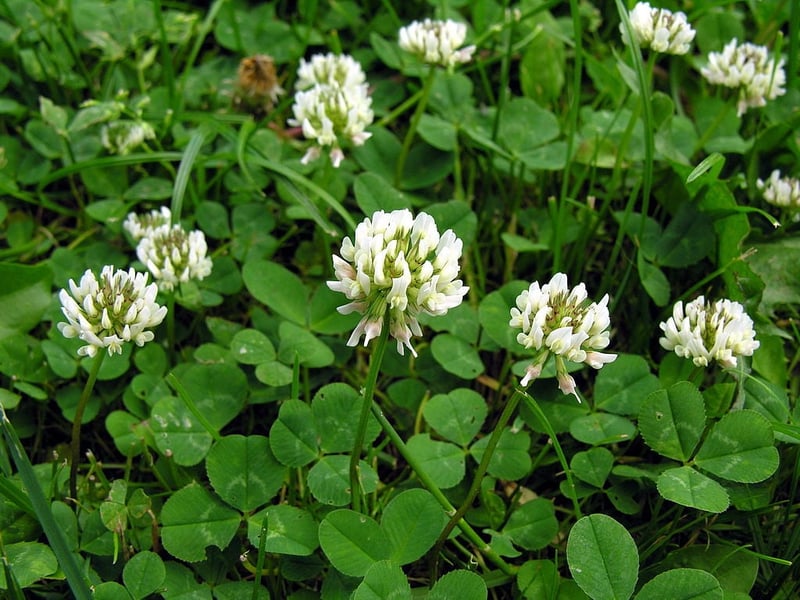 Clover hugs the ground pretty closely so it can outlast lawn mowing. This seemingly innocent little white-flowered weed will choke out your lawn if given the chance. It also attracts bees, which become an additional nuisance.
Clover hugs the ground pretty closely so it can outlast lawn mowing. This seemingly innocent little white-flowered weed will choke out your lawn if given the chance. It also attracts bees, which become an additional nuisance.
Thick, properly fertilized lawns can crowd out clover. Clover also likes to grow in lawns with a low soil pH or compacted soils. Correcting soil pH and aeration can improve overall lawn health and reduce the likelihood of clover and other lawn weeds from dominating. Spraying weeds as they emerge also will help clean things up.
5. Crabgrass
This annual monster of all lawn weeds likes the sun and warm temperatures. It also takes advantage of thin or stressed lawns where it can bully its way in. Lawns without enough water, adequate nutrition or drainage are prime targets.
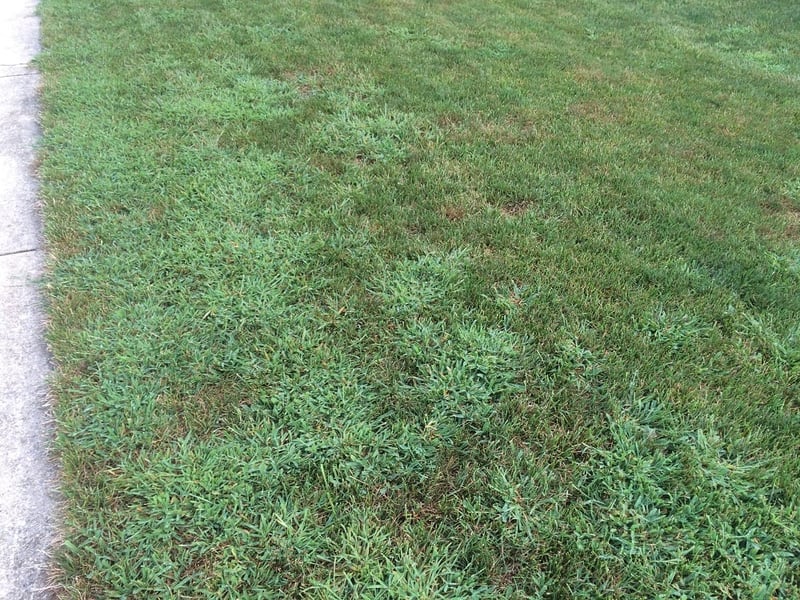 And once crabgrass starts to rapidly mature, it becomes aggressive. When thick crabgrass patches form, they choke out desirable grass. Then when it dies out, it leaves thin, bare areas behind that just fill in with more weeds later on. Each plant can actually produce over 75,000 seeds so the problem can continue to escalate year after year! It’s definitely the biggest of Maryland’s lawn weeds.
And once crabgrass starts to rapidly mature, it becomes aggressive. When thick crabgrass patches form, they choke out desirable grass. Then when it dies out, it leaves thin, bare areas behind that just fill in with more weeds later on. Each plant can actually produce over 75,000 seeds so the problem can continue to escalate year after year! It’s definitely the biggest of Maryland’s lawn weeds.
Preemergent weed control is the best way to get a head start on stopping crabgrass before it starts. However, it’s common to have breakthrough along edges or thin spots. Post-emergent crabgrass control can help with this, particularly when plants are small.
Common Lawn Weeds in Maryland: Late Summer Weeds
Then there are the late summer annual lawn weeds. You’re trying to round out your summer with some fun outdoor plans, and these weeds make their appearance like they came fashionably late to your party.
6. Lespedeza
Lespedeza, also known as Japanese clover, has three smooth oblong leaves similar to clover with small pink to purple flowers. As this weed matures, its stems harden and become more persistent, giving your lawn a real battle.
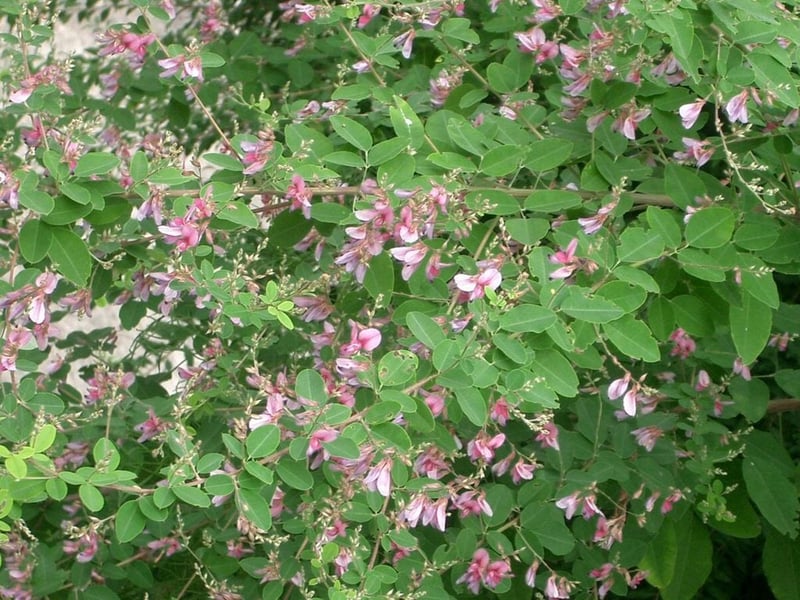 Preemergent herbicide treatments in spring can prevent the late summer arrival of lespedeza. Post-emergent materials can help to knock it back if it emerges later in the season.
Preemergent herbicide treatments in spring can prevent the late summer arrival of lespedeza. Post-emergent materials can help to knock it back if it emerges later in the season.
7. Black Medic
Black medic may look a little like clover with its teardrop-shaped leaves and even has similarities to lespedeza.
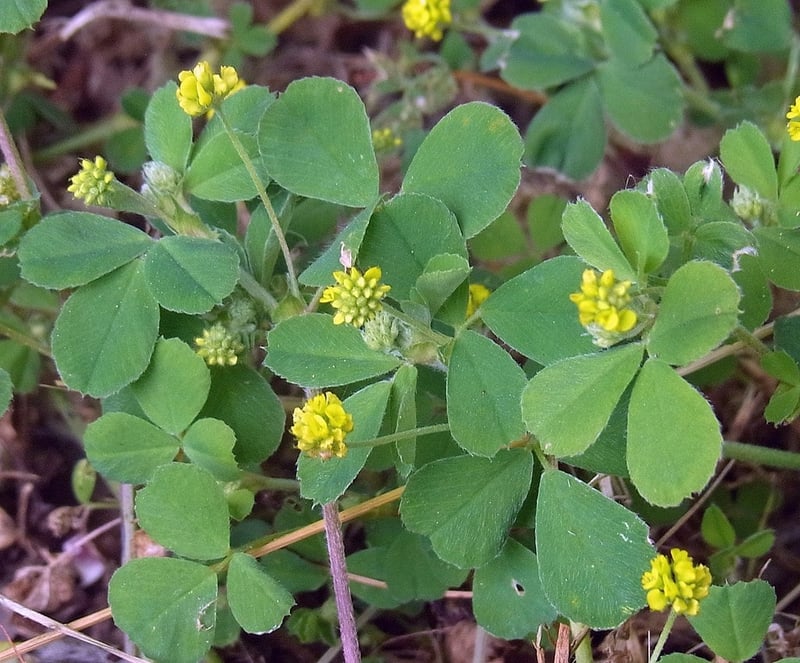 The biggest difference between black medic and lespedeza in the world of lawn weeds is it has yellow flowers versus pink/purple flowers.
The biggest difference between black medic and lespedeza in the world of lawn weeds is it has yellow flowers versus pink/purple flowers.
Black medic also grows low--so mowing doesn’t impact it and it can easily sneak into your lawn and then hide out.
Maintaining a thick lawn can help to reduce this weed and selective weed control materials can help to clean up this summertime invader.
8. Spotted Spurge
Spotted spurge is another one of the summer lawn weeds that thrive in the heat. It takes up residence in weak lawn areas with its hairy red stems and tiny dark green leaves with red spots and it’s stems have a thick, milky sap.
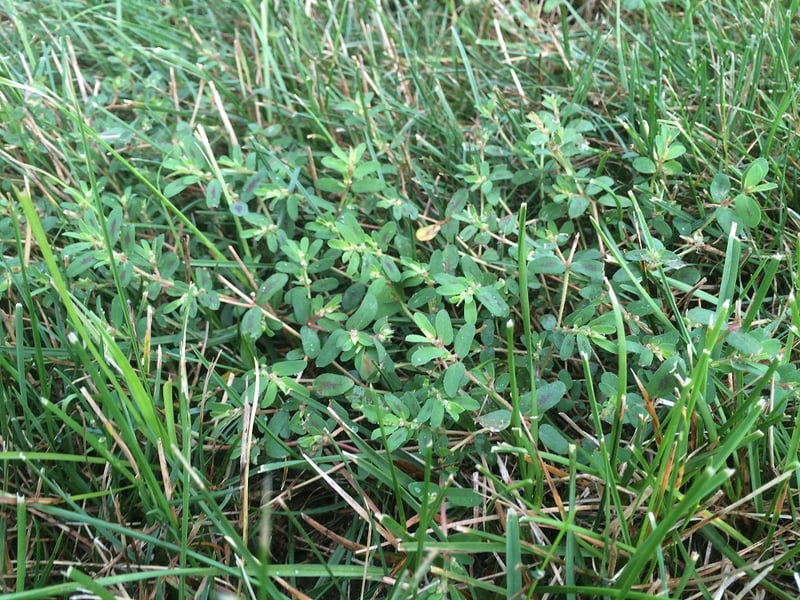 Spotted spurge plants can produce thousands of seeds that can lay dormant in your lawn until those temperatures heat up enough for it to sprout. Then it can even stretch into a thick mat of weeds up to 3 feet long.
Spotted spurge plants can produce thousands of seeds that can lay dormant in your lawn until those temperatures heat up enough for it to sprout. Then it can even stretch into a thick mat of weeds up to 3 feet long.
For these late summer lawn weeds, regular fertilization, particularly in the fall, can help reduce them, as well as a well-watered lawn that isn’t stressed. Spot spraying weeds after they’ve emerged is also a great removal strategy.
Common Lawn Weeds in Maryland & Their Bullying Tendencies
Whether it’s early spring, summer or later in the season, weeds are opportunistic. They see a lawn that lacks nutrients, lacks drainage, is thin or stressed and they attack without hesitation. Hot, dry soil without lawn competition is where lawn weeds thrive.
A healthy lawn is one that is mowed to a higher height, watered appropriately (not too much and not too little) and has the proper balance of nutrients. The goal is to create an optimum environment for grass to grow over weeds. A thick, thriving lawn has the power to repel weeds … but they can still break through.
We’re Here For You When Lawn Weeds Show Up in Southern & Central Maryland
Many times weed seeds can sit and wait until the conditions are just right to erupt. And every weed is different and thrives in various conditions. When they take over your lawn, it makes your yard look like the most neglected one on the street.
Choosing Natural Green for complete, proactive lawn care services that include proper fertilization, as well as both weed preventive and curative treatments throughout the growing season, makes you the smartest neighbor on the block. It’s the best way to keep your lawn weed-free.
Just like lawn weeds hang out for a while once they appear, they also don’t just disappear overnight. Weed seeds are everywhere—from your neighbor’s yard to that bird’s beak as he flies overhead. Our consistent monitoring and control, as well as building up lawn health, gives your lawn a chance to fight back and become more weed resistant.
Are lawn weeds keeping you from having a lawn you can be proud of? We’d love to learn more. Get started today with a free quote. Together, we’ll prepare a customized plan that leads you to the best choice for you and your lawn.
Image sources: chickweed, bittercress, clover, lespedeza, black medic
When it comes to your image of the perfect lawn, there is probably one thing that will spoil your vision more than anything else: weeds.
They’re tall and prickly and spiky and look completely out of place in your well-manicured front yard. What’s more, is they make your lawn look neglected and take away from the overall beauty and enjoyment of your yard!
Lawn weeds are the worst because they sneak in before your lawn has a chance to get nice and thick during the growing season. And just when you’re getting ready to get out there and enjoy your lawn via a nice game of fetch with the dog or to just unwind after a hard day, those weeds come along and ruin it.
Weeds are advantageous. They like to pop in whenever they get the chance. You don’t want those weeds popping up throughout the growing season, taking away from the overall beauty and enjoyment of your lawn.
Here are 8 of the most common lawn weeds in Maryland and how you can keep them out of your lawn.
Common Lawn Weeds in Maryland: Spring Weeds
Let’s start with the early spring invaders. These are winter weeds that actually germinate in the late fall and then grow very slowly winter long, making their appearance most known in spring.
Use This Lawn Weed ID Tool to Spot Weeds in Your Lawn
These are the first lawn weeds that show up right when you’re eager to get outside and enjoy the warmer weather. They are your first unwelcome visitors that stand out very clearly when you’re paying so much attention to the sunshine and the fresh air.
1. Chickweed
Chickweed is common and one of the easiest to spot lawn weeds, growing low with white flowers. There are five petals on each of the flowers, resembling little stars.
 And a wet, early spring powers chickweed even more. Follow that up with early summer rains and chickweed will linger.
And a wet, early spring powers chickweed even more. Follow that up with early summer rains and chickweed will linger.
2. Henbit
Henbit is a winter annual weed as well.
 This is one of the lawn weeds that stands out in the spring with deep purple flowers. After this lawn weed flowers, it’s more difficult to control. But then they usually die back when warmer weather arrives in late spring. However, that could be months later.
This is one of the lawn weeds that stands out in the spring with deep purple flowers. After this lawn weed flowers, it’s more difficult to control. But then they usually die back when warmer weather arrives in late spring. However, that could be months later.
3. Bittercress
Bittercress is the worst because it can grow into a tall eyesore if left to its own demise. And when bittercress reaches its full height, the seed pods actually explode and you’ll have more of this weed next year.
 Excess water and rain, as well as poor drainage, can make these lawn weeds worse.
Excess water and rain, as well as poor drainage, can make these lawn weeds worse.
For these early spring lawn invaders, a thick, healthy lawn is your best defense. If you know you have a spring weed problem, we can treat them as part of a comprehensive lawn care program to keep them at bay.
Common Lawn Weeds in Maryland: Early Summer Weeds
Once the weather warms up even more and spring rains subside, that hot and dry weather is rolling out the red carpet for lawn weeds.
4. Clover
Sure, finding a four-leaf clover is supposed to bring you luck. The problem is most clover only has three leaves … and it can take over your lawn.
 Clover hugs the ground pretty closely so it can outlast lawn mowing. This seemingly innocent little white-flowered weed will choke out your lawn if given the chance. It also attracts bees, which become an additional nuisance.
Clover hugs the ground pretty closely so it can outlast lawn mowing. This seemingly innocent little white-flowered weed will choke out your lawn if given the chance. It also attracts bees, which become an additional nuisance.
Thick, properly fertilized lawns can crowd out clover. Clover also likes to grow in lawns with a low soil pH or compacted soils. Correcting soil pH and aeration can improve overall lawn health and reduce the likelihood of clover and other lawn weeds from dominating. Spraying weeds as they emerge also will help clean things up.
5. Crabgrass
This annual monster of all lawn weeds likes the sun and warm temperatures. It also takes advantage of thin or stressed lawns where it can bully its way in. Lawns without enough water, adequate nutrition or drainage are prime targets.
 And once crabgrass starts to rapidly mature, it becomes aggressive. When thick crabgrass patches form, they choke out desirable grass. Then when it dies out, it leaves thin, bare areas behind that just fill in with more weeds later on. Each plant can actually produce over 75,000 seeds so the problem can continue to escalate year after year! It’s definitely the biggest of Maryland’s lawn weeds.
And once crabgrass starts to rapidly mature, it becomes aggressive. When thick crabgrass patches form, they choke out desirable grass. Then when it dies out, it leaves thin, bare areas behind that just fill in with more weeds later on. Each plant can actually produce over 75,000 seeds so the problem can continue to escalate year after year! It’s definitely the biggest of Maryland’s lawn weeds.
Preemergent weed control is the best way to get a head start on stopping crabgrass before it starts. However, it’s common to have breakthrough along edges or thin spots. Post-emergent crabgrass control can help with this, particularly when plants are small.
Common Lawn Weeds in Maryland: Late Summer Weeds
Then there are the late summer annual lawn weeds. You’re trying to round out your summer with some fun outdoor plans, and these weeds make their appearance like they came fashionably late to your party.
6. Lespedeza
Lespedeza, also known as Japanese clover, has three smooth oblong leaves similar to clover with small pink to purple flowers. As this weed matures, its stems harden and become more persistent, giving your lawn a real battle.
 Preemergent herbicide treatments in spring can prevent the late summer arrival of lespedeza. Post-emergent materials can help to knock it back if it emerges later in the season.
Preemergent herbicide treatments in spring can prevent the late summer arrival of lespedeza. Post-emergent materials can help to knock it back if it emerges later in the season.
7. Black Medic
Black medic may look a little like clover with its teardrop-shaped leaves and even has similarities to lespedeza.
 The biggest difference between black medic and lespedeza in the world of lawn weeds is it has yellow flowers versus pink/purple flowers.
The biggest difference between black medic and lespedeza in the world of lawn weeds is it has yellow flowers versus pink/purple flowers.
Black medic also grows low--so mowing doesn’t impact it and it can easily sneak into your lawn and then hide out.
Maintaining a thick lawn can help to reduce this weed and selective weed control materials can help to clean up this summertime invader.
8. Spotted Spurge
Spotted spurge is another one of the summer lawn weeds that thrive in the heat. It takes up residence in weak lawn areas with its hairy red stems and tiny dark green leaves with red spots and it’s stems have a thick, milky sap.
 Spotted spurge plants can produce thousands of seeds that can lay dormant in your lawn until those temperatures heat up enough for it to sprout. Then it can even stretch into a thick mat of weeds up to 3 feet long.
Spotted spurge plants can produce thousands of seeds that can lay dormant in your lawn until those temperatures heat up enough for it to sprout. Then it can even stretch into a thick mat of weeds up to 3 feet long.
For these late summer lawn weeds, regular fertilization, particularly in the fall, can help reduce them, as well as a well-watered lawn that isn’t stressed. Spot spraying weeds after they’ve emerged is also a great removal strategy.
Common Lawn Weeds in Maryland & Their Bullying Tendencies
Whether it’s early spring, summer or later in the season, weeds are opportunistic. They see a lawn that lacks nutrients, lacks drainage, is thin or stressed and they attack without hesitation. Hot, dry soil without lawn competition is where lawn weeds thrive.
A healthy lawn is one that is mowed to a higher height, watered appropriately (not too much and not too little) and has the proper balance of nutrients. The goal is to create an optimum environment for grass to grow over weeds. A thick, thriving lawn has the power to repel weeds … but they can still break through.
We’re Here For You When Lawn Weeds Show Up in Southern & Central Maryland
Many times weed seeds can sit and wait until the conditions are just right to erupt. And every weed is different and thrives in various conditions. When they take over your lawn, it makes your yard look like the most neglected one on the street.
Choosing Natural Green for complete, proactive lawn care services that include proper fertilization, as well as both weed preventive and curative treatments throughout the growing season, makes you the smartest neighbor on the block. It’s the best way to keep your lawn weed-free.
Just like lawn weeds hang out for a while once they appear, they also don’t just disappear overnight. Weed seeds are everywhere—from your neighbor’s yard to that bird’s beak as he flies overhead. Our consistent monitoring and control, as well as building up lawn health, gives your lawn a chance to fight back and become more weed resistant.
Are lawn weeds keeping you from having a lawn you can be proud of? We’d love to learn more. Get started today with a free quote. Together, we’ll prepare a customized plan that leads you to the best choice for you and your lawn.
Image sources: chickweed, bittercress, clover, lespedeza, black medic


